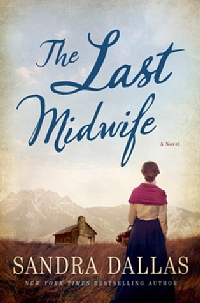
The Last Midwife
by Sandra Dallas
St. Martin’s Press, 2015
Reviewed by Barbara Free
and Jenna Wiley
Gracy is a traditional, very skilled, woman, who was raised by Nabbie, a single woman and midwife who had delivered her, because Gracy’s mother could not care for her, having nine young children already. She delivered babies from the age of ten, having been trained by Nabbie, who believed Gracy had a real gift for healing.
The book primarily focuses on Gracy, now an older woman, being accused of murder after a newborn she had attended a few days after his birth died. She had not delivered this baby, whose grandfather had a huge resentment against Gracy’s husband. The story is told in vignettes and Gracy’s memories, so that only gradually does the reader know more about Gracy, her husband, their son, and other relationships, until at the very end, when “the rest of the story” comes out and adoption connections and step-parent connections are revealed.
This is a very enjoyable took, the kind one stays up way too late reading, because you can’t wait to see what happens next. It is fiction and couldn’t be described as “fun,” unlike another of the author’s books, Chili Queen, but it is a pleasure to read, probably historically pretty accurate, and gives the reader some insights into how people lived and dealt with life’s issues in the 1880s, when many of our grandparents and great grandparents were living, as well as the informal foster and adoption practices of that time, when there were no agencies or foster systems in pioneer settings in the West.
Although the main character is a woman, this book would be enjoyable reading for both men and women of any age.
Excerpted from the January 2016 edition of the Operation Identity Newsletter
© 2016 Operation Identity